Culture
How This Schoolteacher Is Blending Education With Heritage Conservation
Aravindan Neelakandan
May 09, 2018, 05:12 PM | Updated 05:12 PM IST
Save & read from anywhere!
Bookmark stories for easy access on any device or the Swarajya app.
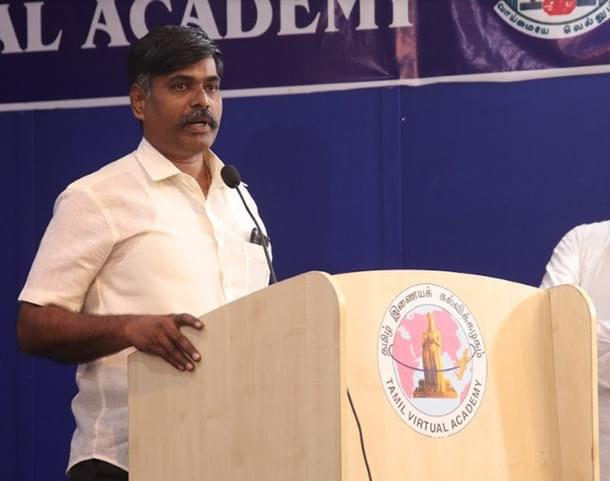
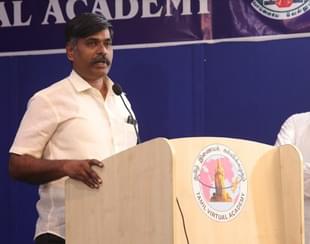
What is the problem with heritage conservation in India? Perhaps, it is the problem of plenty. Archaeological departments across the country also have the problem of the colonial legacy. For the British, the past, particularly the pagan past, meant that it could be restricted to the museums as preserved legacies of a disconnected past. What we have in India is a 'living heritage'. It is artistic, historical and in its core, spiritual. So every village has 'living' temples, the youngest of them may be a few centuries old. And how does one expect the Archaeological Survey of India or the state archaeological boards to conserve and protect these age-old monuments, the inscriptions and the various structural and functional components of the heritage, which are very much a part of our living culture?
A schoolteacher in a dusty quasi town government school in Tamil Nadu may have come up with a solution, which is truly inspiring. It all started with a routine government order – 045959/PD1/E2/2010 – which was released on 30 June 2010 with guidelines for government schools to set up a heritage club. It was a task usually entrusted upon Tamil or history teachers. Usually, it is a namesake exercise, which includes conducting a few meetings, writing the accounts, taking pictures and then forgetting the whole thing altogether. But at the Thirupullani Government School, when other teachers shied away from taking responsibility, V Rajaguru, an English teacher, volunteered to start the heritage club.
Rajaguru charted his own course as he was not interested in enrolling a large number of students. Instead, he selected those who were keenly interested in the history and oral traditions of their villages, habitats, family heritage etc. To this small band of girls and boys, the instruction was how to collect and record these oral traditions and identify historically-important places in their village temples. Soon, the students grasped the essentials of a good social scientist – to talk to varied sources, recording the information, correlating the oral traditions with the historical monuments they saw in their villages, whether it was a roadside inscription, a sculptor or an unexplained statue inside the village temple.
Thirupullani is an important Vaishnavite pilgrimage centre. According to a legend, it was the place where Sri Rama performed a penance before launching his campaign against Ravana, the tyrant of Lanka. The temple complex hosts many interesting legends, which can provide us a peep into how the society lived in the past.
Consider this episode:
A local oral tradition sheds light on how a Sethupathi king, in the eighteenth century, wanted to marry the sister (a widow) of a warrior called Muthu Veerapan. The warrior refused. As a punishment for disobedience, the king told the warrior to harvest a huge plot of millets all by himself. To the astonishment of the king, Veerapan accomplished the task. Fearing that the warrior may pose a threat to his life, the king imprisoned him. But imprisonment could not break the spirit of the warrior. During this time, a series of thefts occurred in Thirupullani temple. The jewels of the residing deity, a goddess, were stolen. Despite the king stationing his most able men to keep a watch, the thief could not be caught. As Veerapan was the family custodian of the temple, he requested the king to release him so that he could catch the thief. The Sethupathi king agreed and said that if he succeeded in catching the thief, he would honour him in such a way that the warrior would be remembered as long the temple existed. As Veerapan lay in wait for the ambush at the western gate of the temple, the thief entered the temple premises with his body smeared in oil. When Veerapan caught him, he simply slipped away and started running. Veerapan chased him over a distance of 3 kilometres and managed to catch him by his hair. A scuffle ensued in which the thief called Sangli, was killed. As a reward, the king not only freed the warrior permanently, but in the way of both atonement and honour, he gave the warrior and his family the honour of holding the rope of the temple chariot first during the chariot festival. The village he lived was renamed after him. Then as promised the king also erected a statue of this warrior inside the temple – a great honour even by today's standards.
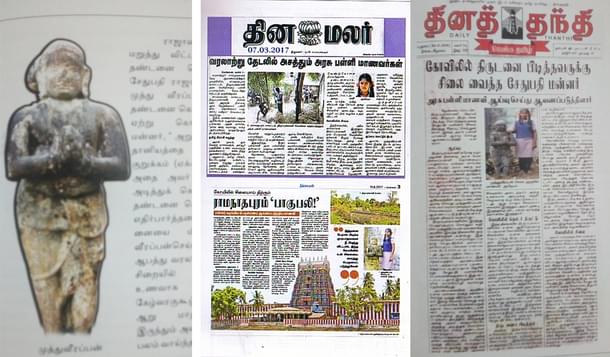
So, when Abinaya, one of the students of Rajaguru, started researching about the name of her own village called 'Muthu Veerappan Valasai', she heard this folklore from her mother and from other village elders. Soon she set out to search for the promised statue of the warrior which she discovered with a turban and folded hands just outside the goddess sanctum inside the temple. Soon experts also announced that the statue was that of Veerapan. It was a matter of great pride to the village elders and an inspiration to the village youths. The district collector himself honoured the girl, who restored the promise that Sethupathi had made to the warrior. There was extensive coverage of this event in the local newspapers and television channels.
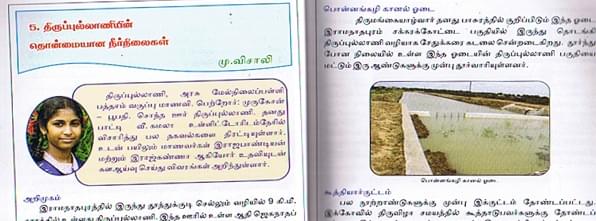
The students from Abinaya's school have also documented the traditional water bodies in and around the area. When a village water canal, which was lying unattended to, was discovered to be a part of a song sung by Thirumangai Azhwar, the famous Vaishnavite azhwar, it acquired a historical and spiritual significance. Visali, another student, in her work on Ponnangali canal, confirms that this was actually sung by the azhwar. She has also documented the beautiful stone structures in the traditional water harvesting and water management systems in the area. In this arid zone, the study of such structures has not only cultural significance but also ecological significance. Hasina Begum and Silmya Banu have recorded the history and worship tradition in 'Nayinar Ayya' Dargah. The Dargah, built in 1950s, has a tradition of serpent veneration.
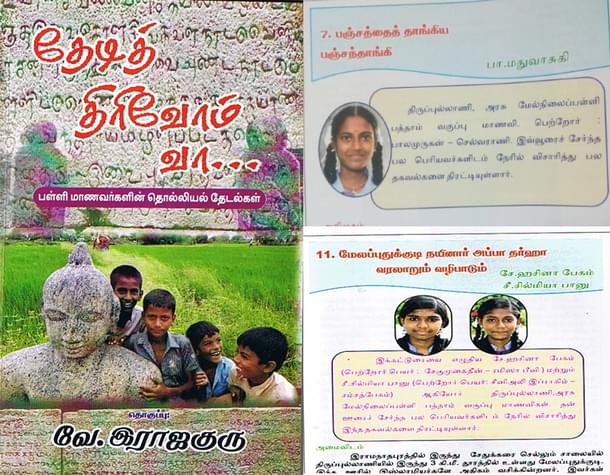
Thus students of Rajaguru have achieved what needs to be accomplished in an ideal education system – being sensitive to the living space – the village or town in an intelligent and inquisitive way. In the process, he has turned the students into both researchers and preservers of the local heritage. Today, his students can read the inscriptions. There are students in this government school who can write in Brahmi and a few even in Vattezhuthu – an ancient form of Tamil writing seen in old inscriptions – not many PhD holders in history could do that. Students have also unearthed and identified, based on oral traditions and their own observations, idols of Buddha and Jain teerthankaras. They have also recorded the events that happen during the local festivals, including the rich and diverse local delicacies offered to the deities.
All these are a result of the determination of a teacher, who out of his own interest, used the school system to make it work for the cause of heritage conservation. He has discovered the symbiotic and decentralised way in which we can use the students to preserve the cultural and natural heritage of our villages, while at the same time make the students good researchers and producers of knowledge.
The efforts of Rajaguru were recognised, and he was honoured by REACH Foundation, run by former Archaeological Survey of Kerala director (retired) Dr Sathyamurthy. REACH Foundation has been working for the scientific restoration of temples throughout Tamil Nadu. The award was handed over by former minister of state for shipping G K Vasan, himself a patron of cultural heritage at an event organised in Chennai on 29 April 2018.
Rajaguru has published a compilation of discoveries made by his students in the form of a book with photographs. It provides a template by which we can use the students as decentralised and effective intelligent symbiotic forces for heritage conservation. If one government school with one inspired student can produce this kind of documentation and awareness, imagine what all the schools across India can produce?
This article is part of the Swarajya heritage programme. If you liked this article and would like us to do more of the kind, consider being a sponsor – you can contribute as little as Rs 2,999. Read more here.
Aravindan is a contributing editor at Swarajya.





